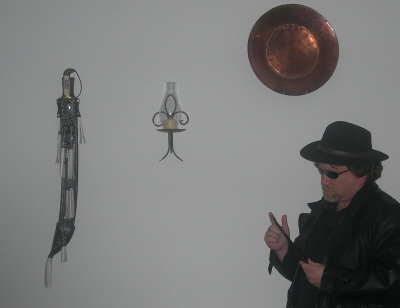|
About This Author
Come closer.
|
Complex Numbers
Complex Numbers
A complex number is expressed in the standard form a + bi, where a and b are real numbers and i is defined by i^2 = -1 (that is, i is the square root of -1). For example, 3 + 2i is a complex number.
The bi term is often referred to as an imaginary number (though this may be misleading, as it is no more "imaginary" than the symbolic abstractions we know as the "real" numbers). Thus, every complex number has a real part, a, and an imaginary part, bi.
Complex numbers are often represented on a graph known as the "complex plane," where the horizontal axis represents the infinity of real numbers, and the vertical axis represents the infinity of imaginary numbers. Thus, each complex number has a unique representation on the complex plane: some closer to real; others, more imaginary. If a = b, the number is equal parts real and imaginary.
Very simple transformations applied to numbers in the complex plane can lead to fractal structures of enormous intricacy and astonishing beauty.
October 18, 2022 at 12:01am October 18, 2022 at 12:01am
| |
In today's "we were wrong all along" news...
Goodbye to the Vikings 
The term ‘Viking’ as it is commonly used is misleading, warping our perception of the Middle Ages. It should be retired.
That yipping noise you just heard was the collective barking of Minnesota sportsball fans.
There was no such thing as a ‘Viking’ in the medieval period. Use of the term emerged in the 19th century. The word wicing occurred in Old English and víkingr in Old Icelandic, but were used very differently, to mean something like ‘pirate’.
Which explains much about a certain cruise line and its pricing structure.
In Old Icelandic víkingr could be applied to any pirate regardless of where they came from or when, or what language they spoke; they might be Estonians or Saracens, for example. It is also noteworthy that it is almost never used to describe the people who we today call ‘Vikings’. Many of the men labelled ‘Vikings’ in textbooks and popular histories were warriors led by kings on military expeditions with clear political objectives, such as the Great Heathen Army that fought Alfred the Great or the Norwegian force that accompanied Harald Hardrada to his death at Stamford Bridge in 1066. Calling such people ‘Vikings’ would be like calling 18th century British, French or Dutch naval officers ‘pirates’ simply because they wore vaguely similar hats and sailed vaguely similar ships to Blackbeard.
Have you seen what 18th century British, French, and Dutch naval officers got up to? That's not far off the mark.
The final development, the ‘ethnicisation’ of the word that allows the use of terms such as ‘Viking farms’, ‘Viking towns’ and ‘Viking women and children’, is much more recent and has gradually crept up since the Second World War. This is insidious; by linking military prowess and savagery to an entire ethnic group, it encourages its appropriation by racial supremacists.
Right, because when I think of military prowess and savagery, I think of Scandinavians and not a certain Mongolian.
On the other hand, my ex-wife is of Norwegian descent, so I get the savagery part.
The issue with the term is not merely semantic. This conception of ‘the Vikings’ seriously distorts our understanding of European history. We have tended to group almost all Scandinavian activity between the 790s and the mid-11th century together under the ‘Viking’ label, creating a distinct ‘Viking Age’ and an imagined ‘Viking’ culture and identity. The evidence, however, does not support this analysis.
The article goes on, of course, to explain said evidence, not all of which I'm going to repeat here.
Irish, English and Frankish chronicles generally refer to Scandinavian aggressors as ‘heathens’ and this, rather than any ethnic identity, seems to have been what struck the victims of these attacks as significant. The 793 raid on Lindisfarne, often said to herald the ‘Viking Age’, is described in the Anglo-Saxon Chronicle thus: ‘The ravages of heathen men miserably destroyed God’s church on Lindisfarne with plunder and slaughter.’
Hey, Lindisfarne again (from a couple of entries ago).
The construct of the ‘Vikings’ conflates and blurs the distinction between eighth- and 12th-century pirates. Tenth-century kings based in Dublin and Christian rulers such as Cnut, all of whom lived in very different societies, had different belief systems and political and economic objectives. Each of these contexts needs to be dealt with on its own terms and not within a 19th-century construct that has more than a hint of racist essentialism to it.
It's also, insofar as I can infer from this article, religious exceptionalism. |
© Copyright 2025 Waltz Invictus (UN: cathartes02 at Writing.Com). All rights reserved.
Waltz Invictus has granted InkSpot.Com, its affiliates and its syndicates non-exclusive rights to display this work.
|

